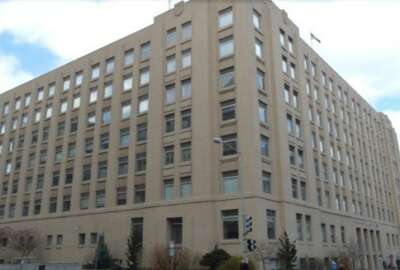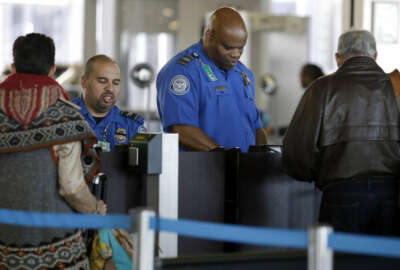

More illegal weapons, more viruses, the return of crowds, and some new buildings — screening for federal facilities is about to get more complicated.
Best listening experience is on Chrome, Firefox or Safari. Subscribe to Federal Drive’s daily audio interviews on Apple Podcasts or PodcastOne.
More illegal weapons, more viruses, the return of crowds, and some new buildings, screening for federal facilities is about to get more complicated. For how this basic but critical function is changing, the Federal Drive with Tom Temin spoke with the CEO of Patriot One, Peter Evans.
Interview transcript:
Tom Temin: Mr. Evans, good to have you on.
Peter Evans: Thank you, Tom, very pleased to be here and joining you.
Tom Temin: You know, the Federal Protective Services and federal operations have always had this issue of screening, and each generation of threat — whether it’s bombings or weapons and so forth, now viruses — it makes getting into federal facilities for even other feds from another agency, let alone contractors and other people that might have business with an agency, it’s really difficult to get in. And it’s hard for the people doing the screening. How do you see this whole process, this whole technology base, changing?
Peter Evans: Tom, it’s a great question. And you know, as a little bit of context, we’ve seen society changed significantly. Certainly in the last five years, but let alone the 10, 20, 30 years. You know, if we think back to 20-30 years ago, when things like walk through metal detectors were first invented, the world was different. We didn’t walk around with smartphones, we didn’t walk around with earbuds, we didn’t walk around with the expectations of an experience that we might have had 20-30 years ago. And so we’re trying to solve — as an industry, as a business, as a society — the rising threats that are going on, the social unrest that we’re all experiencing these days. More of the mass shootings, more of the mass weapons and things like that. We’re trying to solve that, and today’s expectations, with technology that’s 30 or 40 years old. And as a fun analogy, if we were trying to do this podcast today, using technology from 40 years ago, we’d be using fax machines. Now just stop and think about how laughable that would be to do this podcast. You don’t do that. So why are we addressing one of those complex issues we have — protection of people, society, buildings, things like this —with 40-year old technology. It doesn’t make sense. The opportunity we have here is that if you look at what digital innovation does, it’s changed the way that we conduct commerce, it’s changed the way that we do retail, it’s changed the way we do banking. And that same sort of technology can now be applied to this issue of physical security, patrons screening, employee screening, and patron safety and these sorts of things. And so you know, we’re seeing this change in terms of technologies. So you don’t have this this budding of the heads, where more security creates a poor experience. And you know, getting people into a building, you know, I’ve got to go through bags, I’ve got to go through pat downs, I’ve got to go through these screens. It creates long, long lines, it’s creating a kind of an invasion of personal privacy, which is a higher, you know, concern and issue today. And so there’s been this kind of juxtaposition that’s going on.
Tom Temin: Plus it takes forever, too, as the lines grow longer. But the difference between physical screening and, say, some other type of digital transaction is that you’re just exchanging bits. But in the case of physical presence, you have to detect things and there’s technologies that beam stuff and measure things. And so how do you get that down to something manageable?
Peter Evans: Exactly. Well, the technology exists today, in the same way that we do oil exploration, we do exploration for gold and silver and things like that. The same sort of radar technologies that can discern this is gold, this is silver, this platinum in the ground so I can mine that correctly, can be used for things like patron screening, so I could only look at and stop those individuals who indeed actually do have a weapon. Why are we stopping 100% of the people going into building? Why we inspecting everyone that’s going into building? Why are we causing them to separate their bags and their personal items and things like that, their smartphones and things, you know, to have everyone have to go through that process and creating long lines and creating kind of a personal infringement, when you’re really only worried about those people have something malicious, a gun. So with digital technology, the advantages are we can change the way we screen people. Older technologies, 100% of people have to do this to their personal items, their bags, their cell phones and things like that — that creates long lines, creates a lot of personal infringement. With digital technology, you can discern this is a weapon, this is not a weapon. And so 99% of people who are not carrying a weapon are not a threat, they just streamline like they’re walking down the sidewalk. It’s only a 1, 2, 3, 4% or whatever who actually have a gun, a knife, something that’s prohibited out of concern that you need to separate. And so that creates a much faster, frictionless positive experience for individuals going into an office building, a sports stadium, anything like that.
Tom Temin: We’re speaking with Peter Evans, he’s CEO of Patriot One. And so what does this look like? How can you accomplish that?
Peter Evans: They have very simply, I mean, the digital technologies, typically either side of a doorway, you have a couple very simple pillars. They can be covert, they can be behind the walls, put behind the plaster, they can be built into the doorframe, they could look like a couple of planters, right? Or they can be decorated any way you want. If you want it to look like a weapon screening system, we can wrap it that way. But so whether you want it very covert and aesthetically pleasing for an office, or you just want to hide it behind the plaster in a wall, very easy to do.
Tom Temin: Alright, and so it’s still beaming something, but it just does it at high speed when was greater intelligence, in other words.
Peter Evans: Yeah, essentially what you’re doing is think of it like radar technology that’s sending signals out and it’s reflecting certain properties back. A gun gives off a certain kind of signature. The density of the metal, for example, you know, a knife blade gives off certain kind of a signature, versus, say, a cellphone and the kind of, think of it like the reflective properties that come back from that. So it’s very easy to discern this is a cell phone, because how it’s reflecting radar techniques and technologies, versus this is gun, right? And even if you think of something like a 3D plastic gun, okay. For that to be fired a second time, it needs a hardened steel barrel. And that hardened steel barrel gives off a certain signature in response to the radar technology.
Tom Temin: And what about explosives or harmful substances that are not metallic?
Peter Evans: That’s a great question, Tom. I mean, you can also key on the shrapnel that’s in the bomb, but if you look at the unfortunate incidents like something in Kabul, those bombers were intelligent enough to say, we’re gonna use all plastic shrapnel, all plastic explosives and things like that. So what you then do is you start designing your system, that AI system, can start triggering on things like the triggering mechanism. Every bomb needs some sort of igniter, some sort of a triggering mechanism — batteries and igniter. So we started triggering on that and looking for those kinds of things. And that way, you’re always thinking one step ahead. The beauty of the AI systems is they’re a learning system. So the more walkthroughs we go through, the more environments we go through, the more experience and exposure we have to the broad marketplace, the more the systems are constantly gathering data and learning and setting up a signature so that they can then know this is a bomb, this is a ignitive system, this is a weapon.
Tom Temin: And you are testing deployment of this with the Office of Inspector General of the GSA?
Peter Evans: Yes, we are. And we’re very, very pleased with that relationship, because not only is it a great opportunity for us to benefit the federal government more broadly, but they’re actually a nice innovative partner of ours. And so we like working with partners who help us innovate the technology and improve it. And they’re giving us a lot of good insights about what’s the future.
Tom Temin: To test this, say, guns or explosives or whatever, wouldn’t you have to use your technology and then go ahead and screen the person second time in the traditional way to make sure that you got everything before you can just eliminate that second round of old technology?
Peter Evans: So the typical process that a customer of ours employs is individuals just walk through. And if an individual alerts, then they will go and take them over to the investing table, ask them to remove their personal items and come through the system a second time to validate they’re not trying to hide anything. That’s very, very common for buildings, sports stadiums and places like that.
Tom Temin: Yeah, I was gonna say it has to be predicated on a low percentage of people being stopped, or otherwise you’re right back where you started from. And doesn’t everybody have triple-A batteries on them, or some kind of a device with wires that could be in their pocket together and look like an igniter, even though it’s two separate items, like earbuds in a battery?
Peter Evans: It could. And so there’s always going to be some degree of false positives, because there is no perfect system in the world that detects 100% of weapons with 0% of the alerts. And so the difference, though, is you ask yourself, with a walk through metal detector, 100% of the people are being inspected, 100% are having to divest their personal items, versus maybe it’s 5%, maybe it’s 7%, maybe it’s 3%. And 95% of people have a fabulous experience, and they wander right into their place of work. And it’s a much smaller percentage. This allows you to, one, get a better experience; two, manage your security operations better. The number of security staff that you actually need if you’re not inspecting 100% of people. And you can start to then think about optimizing your business with digital insights.
Tom Temin: And maybe people walk around without so much junk on them.
Peter Evans: Or maybe they have more junk on them. Think about a sports stadium where you’ve got individuals who have to carry a bag in — a medical bag or a diaper bag, because you’re a mother or something like that — well now, you don’t have to go to a separate line and go through all the rigmarole of that. It’s almost like you’re being, you know, segregated in society. No, everyone goes in and has the same experience. So you also get to the situation of you’re not creating the haves and have nots. Everyone’s treated very equally.
Tom Temin: Peter Evans is the CEO of Patriot One. Thanks so much for joining me.
Peter Evans: Thank you. It’s been a pleasure, Tom, and thank you so much. I look forward to talking to you again in the future.
Copyright © 2025 Federal News Network. All rights reserved. This website is not intended for users located within the European Economic Area.
Tom Temin is host of the Federal Drive and has been providing insight on federal technology and management issues for more than 30 years.
Follow @tteminWFED



